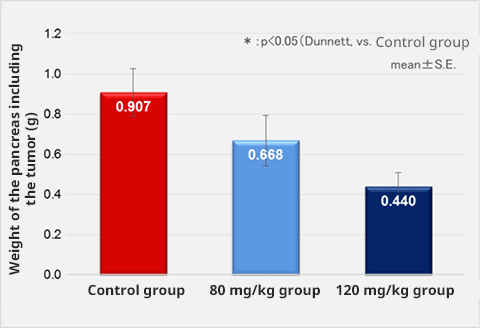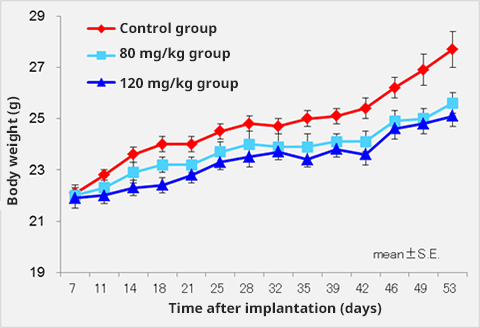BIOSCIENCE Pharmacological studies
Antitumor studies
KAC prepares cancer-bearing animal models by implanting mouse/rat/human cancer cells into the subcutaneous tissue, skin, organs, brain and veins for antitumor evaluation in mice/rats. We also have experience in the provision of cancer-bearing mice.
Study steps
-
- Cell culture
- 2 to 3 weeks
-
- Implantation
- Engraftment and proliferation of tumor (periods differ by cell)
-
- Grouping, administration
- Measurement of diameter of tumors
- Weighing of tumors
Experience
Human tumor cells (Xenograft)| Pancreatic cancer | MIA-PaCa-2 |
|---|---|
| Cervical cancer | HeLa |
| Colon cancer | HCT-116 |
| Glioblastoma | U87-MG |
| Melanoma cancer cell | B16F10 |
|---|

Orthotopic model
Implantation of human pancreatic cancer MIA-PaCa-2 cell into the subcapsular portion of pancreas in nude mice- [Study system]
- BALB/c Slc-nu/nu, male, 6 weeks of age
- [Implantation]
- Cells: human pancreatic cancer MIA PaCa-2 cells, implantation site: subcapsular portion of the pancreas
- [Anticancer drug]
- Gemcitabine, twice weekly in the caudal vein
- [Observation]
- General condition was observed daily after the delivery and body weight was measured once a week or more after the implantation.
Samples were taken on Day 53 of implantation and tumor weight (including the pancreas) was measured.


- [Study system]
- NOD-SCID
- [Implantation]
- Cells: human glioblastoma U87-MG cells,
implantation site: cerebral hemisphere striatum
- [Anticancer drug/mode of administration]
- Temozolomide
- [Observation/sampling]
- Study of survival and proliferation of iPS cell-derived nerve cells implanted into the brain of NOD-SCID mice for evaluation of their tumorigenicity


We use cookies to improve our service.If you continue browsing, we will assume that you agree to the use of such cookies.
+info
[ close ]
[ close ]
